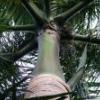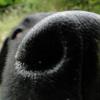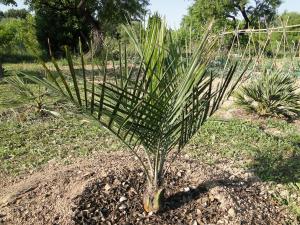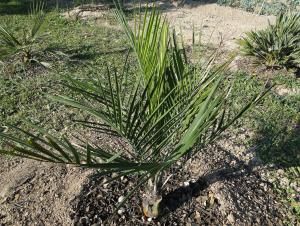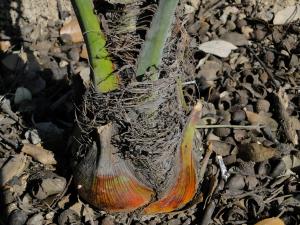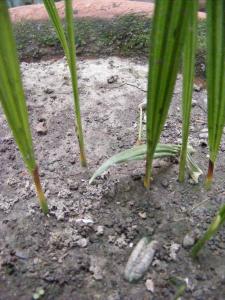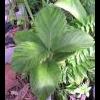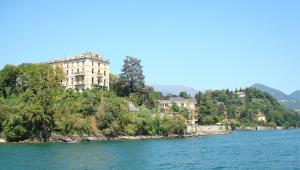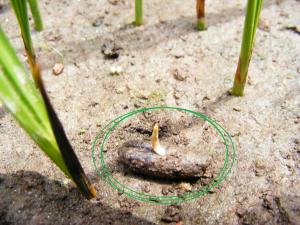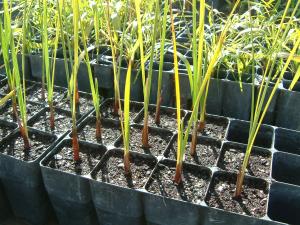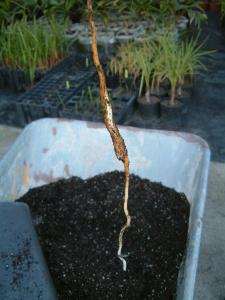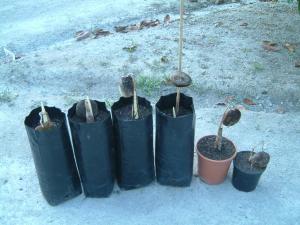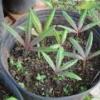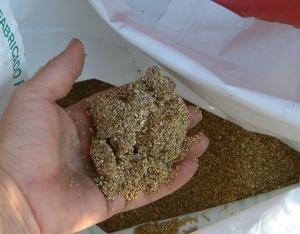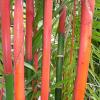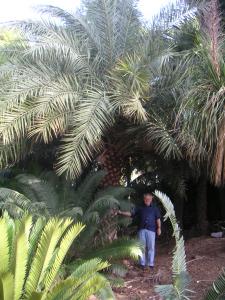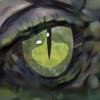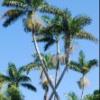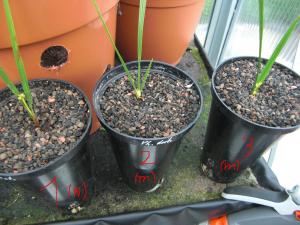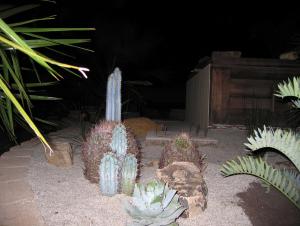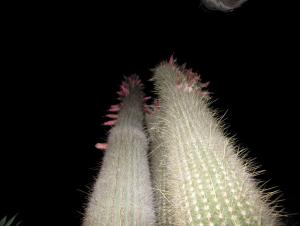Leaderboard
Popular Content
Showing content with the highest reputation on 06/06/2010 in all areas
-
1 point
-
Tried to take some shots for Kris of CIDP's and other Dates: Leaners: A clump: Monolithic:1 point
-
1 point
-
I've never tried germinating palm seeds at home, and last September after finishing a packet of arabian dates (a variety named 'Khastawi'), I planted 20 of the seeds in a 30 litre pot, after keeping them for two months in moist cotton. The pot I kept exposed to the elements in my lawn and I forgot about it completely as nothing ever happened. Well, last week I came home for a week long holiday (just after the rains started) and I was pleasantly surprised to see a whole litter of seedlings beautifully spouted in the pot. I'm pleased as punch by this amateur effort, using as it did, dates packaged in Februar 2009 and planted in September 2009. Now I have big plans for the seedlings, that is once they become a little more sturdy and capable of being transplanted to my lawn. Here are some photographs. I have circled in red one seed that did not germinate.1 point
-
1 point
-
I have 20 Borassus seeds from Kris, that for want of a better phrase, are buried up to their nuts and cooking in black, plastic tubes in the garden. We are up to 35°C /95F in the shade today, and I know that the soil temp for these seeds is reaching nearer 50°C /122F. I'm going to dig them all out, since they've been like this since Christmas. Having successfully germinated and potted two up the previous year, I know that as long as there is a spear and lateral root growth below the stem base, the cotyldonary petiole drying out will not be harmful to the seedling. In fact, the seed is just about done with, if I recall. So I'm off into the garden! It's just gone 7.30pm here. Still +30°C but cooling quickly. Let's shake some Borassus and see what they look like!1 point
-
I see green showing out of my pot that my date is in. It's not a weed. Please help, is this successful germination? Thanks for your help.1 point
-
For ages I've wanted to grow some Nypa palms. They grow wild up the coast from here but in a really difficult to access place. Looking at them in the photo, completely dry (looks like it's the dry season), they'd probably grow in my swamp which does dry out during the dry season. I could give them some irrigation to keep soil humidity levels up during the dry and the rest of the year they'd be standing in water. I'd thought they always needed to be standing in water but it's worth a try.1 point
-
1 point
-
1 point
-
From my web phone it is very difficult to read such a loooooong post, but from my laptop i will pay attention to this thread, as it seems to be lots of interesting.1 point
-
1 point
-
1 point
-
Hello everyone - I found a new nursery that has an enviable collection of palms. After a gruelling two hour journey in the summer heat, these are what I brought home. Dwarf Golden Coconut (C. nucifera) -- I just can't get enough of the yellow leaf bases Bottle Palm (Hyophorbe lagenicaulis) Carpentaria acuminata Triangle Palm (Dypsis decaryi) And finally... an african oil palm -- though I'm having second thoughts since I read online that these get pretty huge. I wanted to get a few spiny species too but it's too dangerous to plant in my lawn.1 point
-
1 point
-
1 point
-
1 point
-
Well done, Jason! That's a natural colour for a leaf tip emerging from total darkness below soil level. Over summer, your little seedling will grow faster if you wait for the soil to feel "dry" in the top half of the pot before watering thoroughly. Moisture content sufficient to prevent roots from dying is about the same as you would find in a bag of compost from a nursery - even less for desert palms. In winter, that's all the moisture it needs, so you shouldn't allow the soil to feel wetter than that, not even at the base of the pot. In summer, aim for the same level of moisture before watering thoroughly. That might mean watering once a week, or every 10 days where you are. These were just watered, but after 3 days in full Mediterranean sun they will need watering right through again. They look yellow too, but that's the sunlight.1 point
-
Nice collection. Yes, African oil palms get quite large so don't plant it near the house. The D. decaryi comes from a drier part of Madagascar, so be sure it doesn't end up in a swampy spot. I made that mistake and mine rotted. Plant it on a mound or in an area that has great drainage.1 point
-
It certainly appears to be a date palm of sorts. But why is the spout so yellow ? That's not a good sign. Date palms usually need plenty of heat, sun and water.1 point
-
Matt, I think the seed is spent once there are lateral roots forming. The one's I grew last year were at this stage when I chopped the cotyldonary petiole almost down to the stem base. They are growing fine. You can see them in post #3 first photo, on the right in the big pots. To update what I said above, Matty, here is a photo of my first two Borassus from last year. I cut the seeds off the day after taking this photo. They had only been potted a week, although I guess it's better to wait until there's a green shoot emerging. I'll put these latest batch of seedlings back in the greenhouse in full shade where they'll get misted 3 times a day with 35°C heat. Once the leaf spear breaks through the seeds are coming off! David (Alicehunter2000) was the one who told me they were good to remove when he saw this photo:1 point
-
If they don't grow into nice fat parsnips, they tend to fall victim to fungus. Germinating Borassus during winter is also a problem for me. In hindsight I should have let these tubes have some sunshine back then. Instead I kept them in the greenhouse. No heat + moisture + undersized seedling = fungal attack. Best I can do is blast it off, dry the seedling then pot it in fresh dirt. In this weather, now exposed to the air, it should heal nicely. Got this going on. Undersized, malformed.. ..or just plain rotted off! You can't know which are the slow ones and water those less, so it's pot luck really. Some seeds are just not strong enough. Here's a little fighter.. Just making the grade.. This is how they should look.. Ready for potting up.. Here are the motley crew! So there it is, as it happened, proving that things don't always turn out as you'd expect. A gift from Kris, and I did my best. I lost 8, potted up 6, and I've got 6 "Big Mamas" which I hope turn out fine. I'll dig those up tomorrow!1 point
-
1 point
-
1 point
-
Well, did you go to the Catamaran? Where are the pictures? Bo-Goran and I left San Diego in 1995 and now here on the Big Island of Hawaii. I miss San Diego. I will alway have a place in my heart for that place. We love it here in HAWAII, and we are not leaving!! Karolyn1 point
-
Sergio, besides that blue question, wich i am not able to answer you, i must say your jubaeas are very very beautiful. How sized are them?? Maybe 1,20 mts?? I have just ordered two 1 mt tall babys, from canarius. Un saludo Sérgio!1 point
-
1 point
-
1 point
-
Hogan just after impact: A couple of CIDP's: An oddity: Date growing out of a Banyan.1 point
-
As a standalone palm, I always thought Mexicanas looked somewhat strange. However planted in that fashion, WOW !!! Spectacular!!1 point
-
Hi yachtingone, I've sent the pictures to Kris via PM. You know, they don't accept posting others pictures but personal ones, on German forum boards - they take copyright infringement very seriously. That's the reason I just linked the photos.1 point
-
1 point
-
1 point
-
1 point
-
1 point
-
1 point
-
1 point
-
Great tour Kim! I was going to go even got the time off work and my brother lives in Ventura but got really sick on Thurs and had to cancel. I'm so glad you took photos.Looks like I missed an incredible garden. I think that is a teddy bear in post 7 and post 8 is belmoreana.1 point
-
Here B. clara seems to tolerate our high humidty much better than B. armata. The B. clara has never had fungal problems while B. armata always was spotted. The B. armata seems to have outgrown this as it is not as bad as it used to be. We did lose a good sized B. clara from a bud rot. The best Brahea seems to be B. elegans. No fungal problems ever and a dwarf. B. armata seems to be more silvery than B. clara which is more blue-green. Brahea elegans has a nice blue coloring. Brahea clara http://pg.photos.yahoo.com/ph.....src=ph Brahea armata http://pg.photos.yahoo.com/ph.....src=ph Brahea elegans http://pg.photos.yahoo.com/ph.....src=ph1 point


